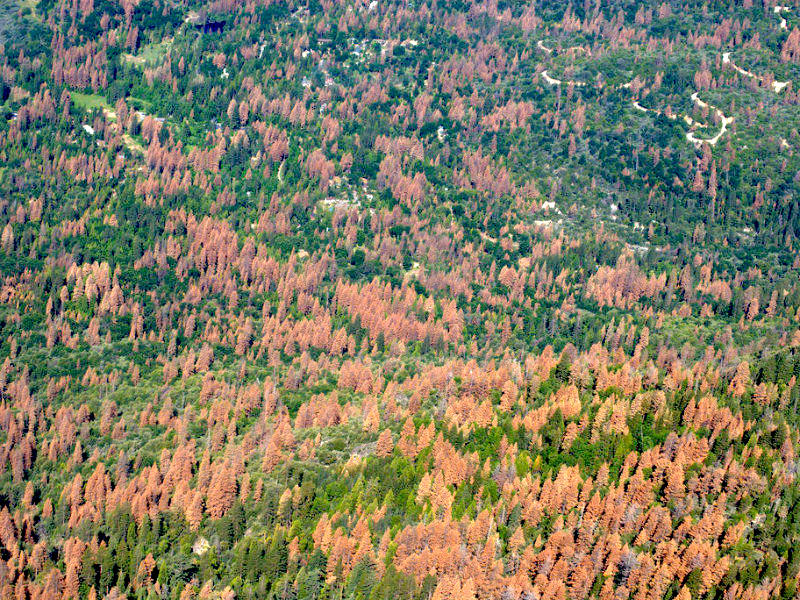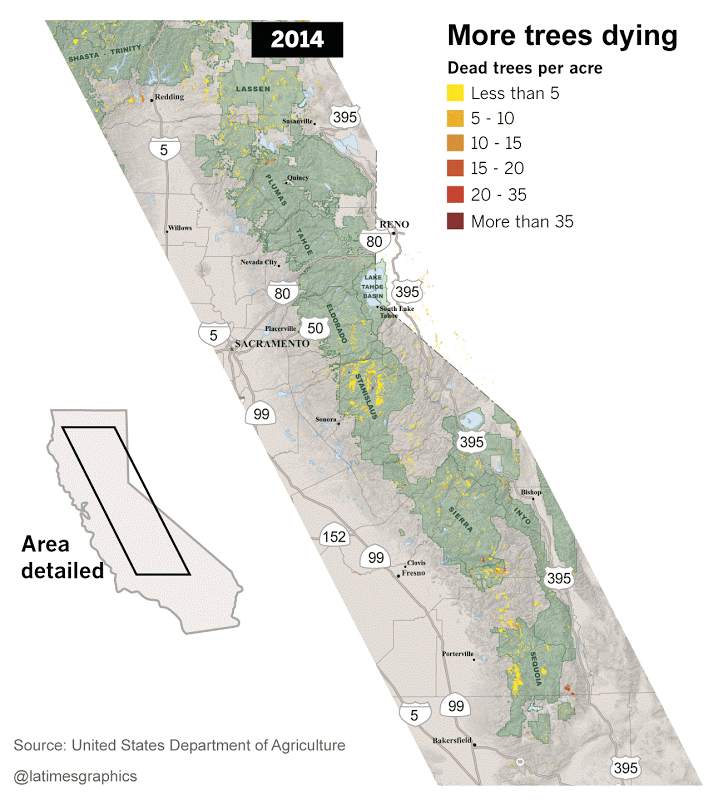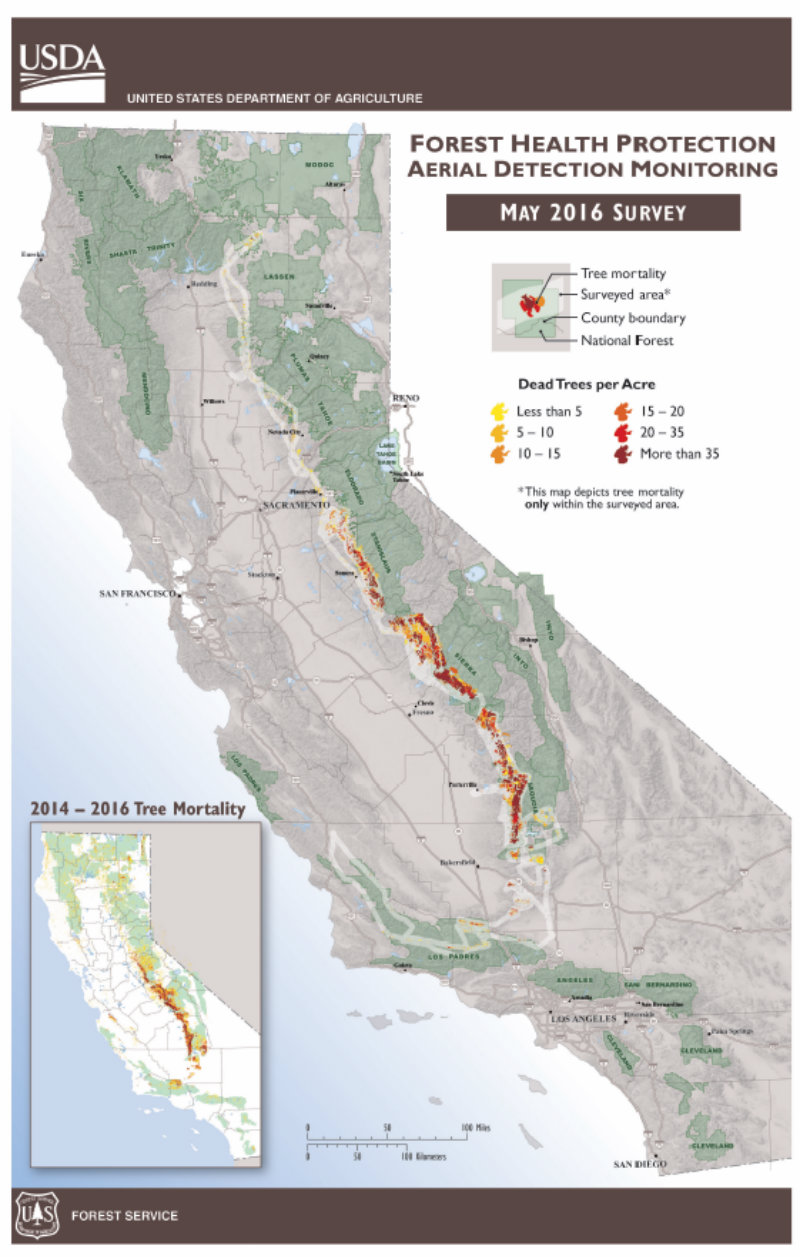
Forest Service Survey Finds Record 66 Million Dead Trees in Southern Sierra Nevada
VALLEJO, CALIF., JUNE 22, 2016 AT 2:30 PM EDT – The U.S. Forest Service today announced that it has identified an additional 26 million trees dead in California since October 2015. These trees are located in six counties across 760,000 acres in the southern Sierra Nevada region of the state, and are in addition to the 40 million trees that died statewide from 2010 to October 2015, bringing the total to at least 66 million dead trees. Four consecutive years of severe drought in California, a dramatic rise in bark beetle infestation and warmer temperatures are leading to historic levels of tree die-off.

“Tree dies-offs of this magnitude are unprecedented and increase the risk of catastrophic wildfires that puts property and lives at risk,” said Agriculture Secretary Tom Vilsack. “While the fire risk is currently the most extreme in California because of the tree mortality, forests across the country are at risk of wildfire and urgently need restoration requiring a massive effort to remove this tinder and improve their health. Unfortunately, unless Congress acts now to address how we pay for firefighting, the Forest Service will not have the resources necessary to address the forest die-off and restore our forests. Forcing the Forest Service to pay for massive wildfire disasters out of its pre-existing fixed budget instead of from an emergency fund like all other natural disasters means there is not enough money left to do the very work that would help restore these high mortality areas. We must fund wildfire suppression like other natural disasters in the country.”

Between 2010 and late 2015, Forest Service aerial detection surveys found that 40 million trees died across California – with nearly three quarters of that total succumbing to drought and insect mortality from September 2014 to October 2015 alone. The survey identified approximately 26 million additional dead trees since the last inventory in October, 2015. The areas surveyed in May covered six southern Sierra counties including Fresno, Kern, Madera, Mariposa, Tuolumne and Tulare. Photos and video of the May survey are available on the Forest Service multimedia webpage.
Last fall, Governor Brown declared a state of emergency on the unprecedented tree die-off in California and formed a Tree Mortality task force to help mobilize additional resources for the safe removal of dead and dying trees. The Forest Service is committing significant resources to restore impacted forests including reprioritizing $32 million in California to conduct safety-focused restoration along roads, trails and recreation sites. To date, the Forest Service has felled over 77,000 hazard trees, treated over 13,000 acres along 228 miles of roads around communities and recreation sites, and created 1,100 acres of fuel breaks. Work on another 15,000 acres is in progress.
Forest Service scientists expect to see continued elevated levels of tree mortality during 2016 in dense forest stands, stands impacted by root diseases or other stress agents and in areas with higher levels of bark beetle activity. Additional surveys across the state will be conducted throughout the summer and fall.
With the increasing size and costs of suppressing wildfires due to climate change and other factors, the very efforts that would protect watersheds and restore forests to make them more resilient to fire in the future are being squeezed out of the budget. Last year fire management alone consumed 56 percent of the Forest Service’s budget.
Learn more about tree mortality and the work to restore our forests in California at the Forest Service’s web page Our Changing Forests.
The mission of the U.S. Forest Service, part of the U.S. Department of Agriculture, is to sustain the health, diversity and productivity of the nation’s forests and grasslands to meet the needs of present and future generations. The agency manages 193 million acres of public land, provides assistance to state and private landowners, and maintains the largest forestry research organization in the world. Public lands managed by the Forest Service contribute more than $13 billion to the economy each year through visitor spending alone and provide 20 percent of the nation’s clean water supply.
My first thought is the Forest Service is feeling the results of letting environmental groups push it around for decades. The management of dead and diseased trees needed to start 50 years ago. When “Climate Change” is used for anything its an excuse. When in history has climate not changed? Who’s to say yesteryear was the perfect climate? Now that we are here I believe we need to salvage the dead trees as fast as possible while reducing fire danger. Somehow congress needs to pass whatever laws speed up the process of harvest.
So why is the foresty cutting down more trees then ever?????